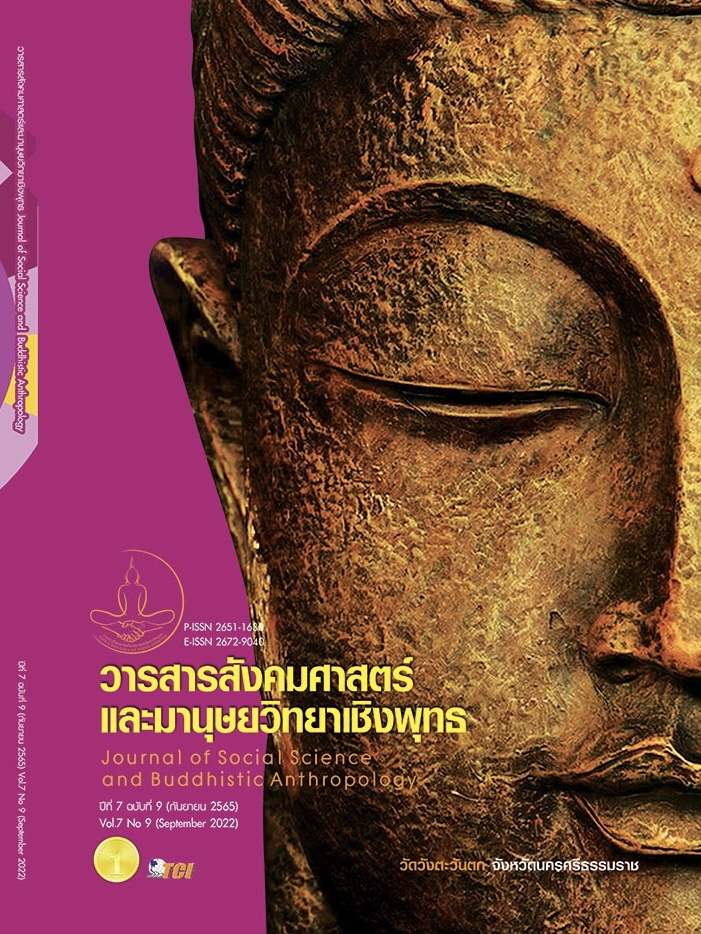DEVELOPMENT OF STRATEGIC LEADERSHIP MODEL FOR THAI INDUSTIAL FACTORIES
Keywords:
Leadership, Strategic Leadership, Strategic Leadership ModelAbstract
The objectives of this research article were to 1) Study the general characteristics of the samples and the importance of factors influencing the development of strategic leadership 2) develop a strategic leadership model for Thai industrial factories; 3) examine the practical suitability of a strategic leadership model for Thai industrial factories. It was a mixed methods research, the research tools were questionnaires and interviews. For the quantitative research, the samples were 480 industrial factories, random sampling by non-probabilistic type and purposive sampling method. And qualitative research was done by in-depth interview and a purposive sampling method of 3 experts in strategic management was randomized. Research data was analyzed using descriptive statistics research. and inferential statistics research. The research results found that most of the samples were medium-sized enterprises, having a business period of 5 - 10 years, having an annual revenue less than 100 million baht, and were located in the Krungthep Mahanakorn. They focused on the factors influencing the success of strategic leadership development, namely the creation of strategic challenges, strategic leadership, coaching, succession of strategic leadership development, building of a collaboration and building of a trust. Overall average value was at the very much up to most levels. As for the strategic leadership model for Thai industrial factories, it was found that it consisted of 6 main components, namely 1) Strategic Leadership 2) Strategic Challenge Creation 3) Coaching 4) Confidence Building 5) Collaboration and 6) Success of Strategic Leadership Development., It was statistically significant at the .05 level and practically appropriate.
References
กรมโรงงานอุตสาหกรรม. (2564). สถิติโรงงานอุตสาหกรรม. สถิติสะสมจำนวนโรงงานที่ได้รับอนุญาตให้ประกอบกิจการ (เปิดดำเนินการ) ตาม พ.ร.บ.โรงงาน พ.ศ. 2535 และ พ.ร.บ.โรงงาน (ฉบับที่ 2) พ.ศ. 2562 จำแนกรายหมวดอุตสาหกรรมที่สำคัญ ตามจำพวก ณ สิ้นปี 2563. เรียกใช้เมื่อ 10 มีนาคม 2564 จาก https://www.diw.go.th/webdiw/static-fac/
กรมโรงงานอุตสาหกรรม. (2564). สถิติโรงงานอุตสาหกรรม. สถิติสะสมจำนวนโรงงานที่ได้รับอนุญาตให้ประกอบกิจการ ตาม พ.ร.บ. โรงงาน พ.ศ. 2535. จำแนกตามจังหวัด รายจำพวก ณ สิ้นปี 2563. เรียกใช้เมื่อ 10 มีนาคม 2564 จาก https://www.diw.go.th /webdiw/static-fac/
กองบริหารงานวิจัยและประกันคุณภาพการศึกษา. (2559). Thailand 4.0 โมเดลขับเคลื่อน ประเทศไทยสู่ความมั่งคั่ง มั่นคง และยั่งยืน. กรุงเทพมหานคร: กองบริหารงานวิจัยและประกันคุณภาพการศึกษา.
กัลยา วานิชย์บัญชา. (2562). การวิเคราะห์สมการโครงสร้าง (SEM) ด้วย AMOS. กรุงเทพมหานคร: สามลดา.
เบญจพนธ์ มีเงิน. (2564). วิธีการวิจัยทางธุรกิจ (Business Research Methods). กรุงเทพมหานคร: ธนะพัฒน์พริ้นติ้งแอนด์พับลิเคชั่น.
รังสรรค์ ประเสริฐศรี. (2551). ภาวะผู้นำ Leadership. กรุงเทพมหานคร: ธีระฟิล์ม และไซเท็กซ์.
รัตนะ บัวสนธ์. (2556). วิธีการเชิงผสมผสานสำหรับการวิจัยและประเมิน. กรุงเทพมหานคร: สำนักพิมพ์แห่งจุฬาลงกรณ์มหาวิทยาลัย.
สถาบันเพิ่มผลผลิตแห่งชาติ. (2552). TQA (Thailand Quality Award). กรุงเทพมหานคร: สถาบันเพิ่มผลผลิตแห่งชาติ.
สุชาติ ประสิทธิ์รัฐสินธุ์. (2544). ระเบียบวิธีการวิจัยทางสังคมศาสตร์. กรุงเทพมหานคร: เฟื่องฟ้าพริ้นติ้ง.
สุวิมล ติรกานนท์. (2550). การสร้างเครื่องมือวัดตัวแปรในการวิจัยทางสังตมศาสตร์: แนวทางสู่การปฏิบัติ. กรุงเทพมหานคร: โรงพิมพ์แห่งจุฬาลงกรณ์มหาวิทยาลัย.
Agranoff , R. (2006). Inside Collaborative Networks: Ten Lessons for Public Managers. Public Admistration Review, 66(S1), 56-65.
Creswell, J. W. & Plano Clark, V. L. (2018). Designing and Conducting Mixed Methods Research (3rd ed.). Thousand Oaks, CA: SAGE.
Daft, R. L. (2005). The leadership experience (3rd ed.). Mason, OH: Thomson South-Western.
Hair, J. et al. (2010). Multivariate data analysis (7th ed.). Upper saddleRiver, New Jersey: Pearson Education International.
Kaplan, R. S & D. P. Norton. (2005). The Office of Strategy Management. Harvard Business Review, 83(10), 72-80.
Navahavandi, A. & Malexzadeh, A. (1993). Leader Style in Strategy and Organizational Performance: An Integrative Framework. Journal of Management Studies, 30(3), 405-425.
Quick MBA. (2010). Thornton’s 3-C Leadership Model. by Quick MBA.Knowledge to Power Your Business. Retrieved March 10, 2021, from http://www.quickmba. com/mgmt/leadership/3c/
Downloads
Published
How to Cite
Issue
Section
License
Copyright (c) 2022 Journal of Social Science and Buddhistic Anthropology

This work is licensed under a Creative Commons Attribution-NonCommercial-NoDerivatives 4.0 International License.








